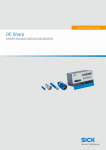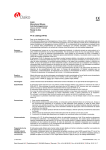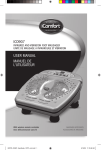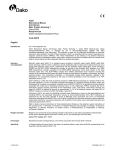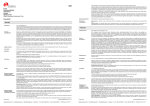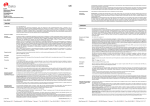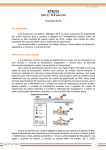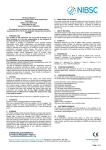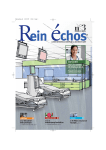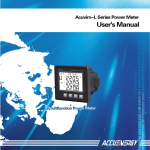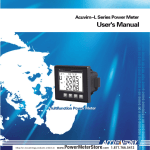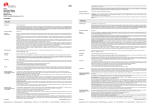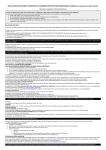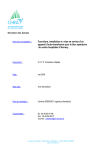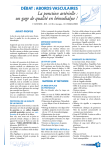Download Dako Autostainer/Autostainer Plus
Transcript
permanent mounting medium is recommended. Positive and negative controls should be run simultaneously using the same protocol as the patient specimens. The positive control tissue should include HCMV-infected tissue and the cells/structures should display reaction patterns as described for this tissue in “Performance characteristics” in all positive specimens. The recommended negative control reagent is FLEX Negative Control, Mouse, (Dako Autostainer/Autostainer Plus) (Code IS750). 0843 FLEX Monoclonal Mouse Anti-Cytomegalovirus Clones CCH2 + DDG9 Ready-to-Use (Dako Autostainer/Autostainer Plus) Staining interpretation The cellular staining pattern is a strong intranuclear reaction. Cytoplasmic staining may be observed. Performance characteristics Cells labeled by the antibody display a nuclear staining pattern early in the HCMV infection. At a later stage, an apparent cytoplasmic staining pattern might be observed (3). Normal tissues: Screening of normal human tissues from donors without HCMV infection with the CCH2 antibody showed no reaction with the heart, lung, liver, kidney, spleen, lymph node, tonsil, bone marrow, skeletal muscle, brain, thyroid and parathyroid glands (1). Abnormal tissues: In HCMV-infected tissues, the CCH2 antibody labeled cells in the lung, liver, kidney, lymph node, brain, thyroid and parathyroid glands (1). The CCH2 and DDG9 antibodies together labeled HCMV-infected tissue of esophagus, stomach, small intestine, colon, gall bladder, lung, adrenal gland, ovary and neural tissue (2). Code IS752 FRANÇAIS ENGLISH Pour utilisation lors d’un diagnostic in vitro. Utilisation prévue For in vitro diagnostic use. Intended use FLEX Monoclonal Mouse Anti-Human Cytomegalovirus, clones CCH2 + DDG9, Ready-to-Use (Dako Autostainer/Autostainer Plus), est destiné à une utilisation en immunohistochimie avec les instruments Dako Autostainer/Autostainer Plus. Cet anticorps permet l'identification des tissus infectés par le cytomégalovirus humain (CMVH) (1, 2). L’interprétation clinique de toute coloration ou son absence doit être complétée par des études morphologiques en utilisant des contrôles appropriés et doit être évaluée en fonction des antécédents cliniques du patient et d’autres tests diagnostiques par un pathologiste qualifié. FLEX Monoclonal Mouse Anti-Human Cytomegalovirus, Clone CCH2 + DDG9, Ready-to-Use (Dako Autostainer/Autostainer Plus), is intended for use in immunohistochemistry together with Dako Autostainer/Autostainer Plus instruments. This antibody is useful for the identification of human cytomegalovirus (HCMV)-infected human tissues (1, 2). The clinical interpretation of any staining or its absence should be complemented by morphological studies using proper controls and should be evaluated within the context of the patient's clinical history and other diagnostic tests by a qualified pathologist. Human cytomegalovirus is a ubiquitous herpes virus. The primary infection usually occurs in childhood where it most often is asymptomatic. After initial exposure, the virus establishes a life-long infection. In neonates, and in immunocompromised individuals, such as AIDS patients and transplant recipients, HCMV can cause severe life-threatening infections, and it is the most common cause of viral birth defects (5-6). Summary and explanation Le cytomégalovirus humain est un virus de l'herpès humain très répandu. L'infection primaire survient généralement durant l'enfance et est le plus souvent asymptomatique. Après l'exposition initiale, l'infection par le virus dure toute la vie. Chez les nouveau-nés et les individus dont l'immunité est compromise, comme les patients atteints du SIDA et les receveurs de greffes, le CMVH peut provoquer des infections sévères, potentiellement mortelles et c'est la cause principale des déficiences congénitales d'origine virale (5–6). Résumé et explication Antibody CCH2 (1) reacts with an early nuclear protein identical with the non-structural DNA-binding protein p52 (7). Antibody DDG9 reacts with an immediate early nuclear protein of about 76 kDa (3). For both antibodies, the reactivity persists also at later stages during the HCMV infection where the localization is less distinctly nuclear and appears to be in the cytoplasm. Laser confocal microscopy, however, shows that the reaction is limited to the nuclear membrane (3). The antibodies do not cross-react with adenovirus, herpes simplex virus, and varicella zoster virus (3). L'anticorps CCH2 (1) réagit avec une protéine nucléaire précoce identique à la protéine p52 non structurelle liant l'ADN (7). L'anticorps DDG9 réagit avec une protéine nucléaire précoce immédiate d'environ 76 kDa (3). Pour les deux anticorps, la réactivité persiste aussi aux stades plus tardifs au cours des infections CMVH et la localisation est moins limitée au noyau et apparaît aussi dans le cytoplasme. Au microscope confocal à balayage laser, on observe cependant que la réaction est limitée à la membrane nucléaire (3). Les anticorps ne présentent pas de réaction croisée avec les adénovirus, le virus de l'herpès ni le virus varicelle zona (3). Refer to Dako’s General Instructions for Immunohistochemical Staining or the detection system instructions of IHC procedures for: 1) Principle of Procedure, 2) Materials Required, Not Supplied, 3) Storage, 4) Specimen Preparation, 5) Staining Procedure, 6) Quality Control, 7) Troubleshooting, 8) Interpretation of Staining, 9) General Limitations. Ready-to-use mixture of two monoclonal mouse antibodies provided in liquid form as cell culture supernatant dialysed against 0.05 mol/L Tris-HCl, 0.015 mol/L NaN3, pH 7.2. Reagent provided Se référer aux Instructions générales de coloration immunohistochimique de Dako ou aux instructions du système de détection relatives aux procédures IHC pour plus d’informations concernant les points suivants : 1) Principe de procédure, 2) Matériels requis mais non fournis, 3) Conservation, 4) Préparation des échantillons, 5) Procédure de coloration, 6) Contrôle de qualité, 7) Dépannage, 8) Interprétation de la coloration, 9) Limites générales. Mélange prêt à l'emploi de deux anticorps monoclonaux de souris, fourni sous forme liquide en tant que surnageant de culture cellulaire, dialysé contre 0,05 mol/L de Tris/HCl et contenant 0,015 mol/L d’azide de sodium (NaN3), à pH 7,2. Réactifs fournis Clones: CCH2 + DDG9 (3). Isotypes: IgG1, kappa (CCH2) and IgG2a, kappa (DDG9). Clones : CCH2 + DDG9 (3). Isotype : IgG1, kappa (CCH2) et IgG2a, kappa (DDG9). Immunogen Crude cell lysates from cytomegalovirus strain Ad169-infected human embryonic fibroblasts (3). Specificity Antibody CCH2 reacts with an early nuclear protein identical with the non-structural DNA-binding protein p52 (7). More than 200 human CMV isolates have been successfully typed by this antibody which, therefore, seems to recognize an epitope which is highly conserved among HCMV strains (3, 4). Immunogène Lysats de cellules brutes de fibroblastes embryonnaires humains infectés par la souche Ad169 du cytomégalovirus (3). Spécificité L'anticorps CCH2 réagit avec une protéine nucléaire précoce identique à la protéine p52 non structurelle liant l'ADN (7). Plus de 200 isolats CMVH ont été répertoriés avec succès par cet anticorps, qui par conséquent semble reconnaître un épitope hautement conservé au sein des souches CMVH (3, 4). Antibody DDG9 reacts with an immediate early nuclear protein of about 76 kDa (3). L'anticorps DDG9 réagit avec une protéine nucléaire précoce immédiate d'environ 76 kDa (3). For both antibodies, the reactivity persists also at later stages during HCMV infection where localization is less distinctly nuclear and appears to be in the cytoplasm. Laser confocal microscopy, however, shows that the reaction is limited to the nuclear membrane (3). Pour les deux anticorps, la réactivité persiste aussi aux stades plus tardifs au cours des infections CMVH et la localisation est moins limitée au noyau et apparaît aussi dans le cytoplasme. Au microscope confocal à balayage laser, on observe cependant que la réaction est limitée à la membrane nucléaire (3). The antibodies do not cross-react with adenovirus, herpes simplex virus, and varicella zoster virus (3). 1. For professional users. 2. This product contains sodium azide (NaN3), a chemical highly toxic in pure form. At product concentrations, though not classified as hazardous, sodium azide may react with lead and copper plumbing to form highly explosive build-ups of metal azides. Upon disposal, flush with large volumes of water to prevent metal azide build-up in plumbing. 3. As with any product derived from biological sources, proper handling procedures should be used. 4. Wear appropriate Personal Protective Equipment to avoid contact with eyes and skin. 5. Unused solution should be disposed of according to local, State and Federal regulations. Precautions Store at 2-8 °C. Do not use after expiration date sta mped on vial. If reagents are stored under any conditions other than those specified, the conditions must be verified by the user. There are no obvious signs to indicate instability of this product. Therefore, positive and negative controls should be run simultaneously with patient specimens. If unexpected staining is observed which cannot be explained by variations in laboratory procedures and a problem with the antibody is suspected, contact Dako Technical Support. Storage Specimen preparation including materials required but not supplied Les anticorps ne présentent pas de réaction croisée avec les adénovirus, le virus de l'herpès ni le virus varicelle zona (3). Précautions 1. Pour utilisateurs professionnels. 2. Ce produit contient de l’azide de sodium (NaN3), produit chimique hautement toxique dans sa forme pure. Aux concentrations du produit, bien que non classé comme dangereux, l’azide de sodium peut réagir avec le cuivre et le plomb des canalisations et former des accumulations d’azides métalliques hautement explosifs. Lors de l’élimination, rincer abondamment à l’eau pour éviter toute accumulation d’azide métallique dans les canalisations. 3. Comme avec tout produit d’origine biologique, des procédures de manipulation appropriées doivent être respectées. 4. Porter un vêtement de protection approprié pour éviter le contact avec les yeux et la peau. 5. Les solutions non utilisées doivent être éliminées conformément aux réglementations locales et nationales. Conservation Conserver entre 2 et 8 °C. Ne pas utiliser après la date de péremption indiquée sur le flacon. Si les réactifs sont conservés dans des conditions autres que celles indiquées, celles-ci doivent être validées par l’utilisateur. Il n’y a aucun signe évident indiquant l’instabilité de ce produit. Par conséquent, des contrôles positifs et négatifs doivent être testés en même temps que les échantillons de patient. Si une coloration inattendue est observée, qui ne peut être expliquée par un changement des procédures du laboratoire, et en cas de suspicion d’un problème lié à l’anticorps, contacter l’assistance technique de Dako. Préparation des échantillons y compris le matériel requis mais non fourni L’anticorps peut être utilisé pour le marquage des coupes de tissus inclus en paraffine et fixés au formol. L’épaisseur des coupes d’échantillons de tissu doit être d’environ 4 µm. The antibody can be used for labeling formalin-fixed, paraffin-embedded tissue sections. Tissue specimens should be cut into sections of approximately 4 µm. Pre-treatment with heat-induced epitope retrieval (HIER) is required using Dako PT Link (Code PT100/PT101). For details, please refer to the PT Link User Guide. Optimal results are obtained by pretreating tissues using EnVision FLEX Target Retrieval Solution, High pH (50x) (Code K8010/K8004). Paraffin-embedded sections: Pre-treatment of formalin-fixed, paraffin-embedded tissue sections is recommended using the 3-in-1 specimen preparation procedure for Dako PT Link. Follow the pre-treatment procedure outlined in the package insert for EnVision FLEX Target Retrieval Solution, High pH (50x) (Code K8010/K8004). Note: After staining the sections must be dehydrated, cleared and mounted using permanent mounting medium. Un prétraitement avec démasquage d’épitope induit par la chaleur (HIER) est nécessaire avec le Dako PT Link (Réf. PT100/PT101). Pour plus de détails, se référer au Guide d’utilisation du PT Link. Des résultats optimaux sont obtenus en prétraitant les tissus à l’aide de la EnVision FLEX Target Retrieval Solution, High pH (50x) (Réf. K8010/K8004). Deparaffinized sections: Pre-treatment of deparaffinized formalin-fixed, paraffin-embedded tissue sections is recommended using Dako PT Link and following the same procedure as described for paraffin-embedded sections. After staining the slides should be mounted using aqueous or permanent mounting medium. Coupes incluses en paraffine : le prétraitement des coupes tissulaires fixées au formol et incluses en paraffine est recommandé à l'aide de la procédure de préparation d'échantillon 3-en-un pour le Dako PT Link. Suivre la procédure de prétraitement indiquée dans la notice de la EnVision FLEX Target Retrieval Solution, High pH (50x) (Réf. K8010/K8004). Remarque : après coloration, les coupes doivent être déshydratées, lavées et montées à l’aide d’un milieu de montage permanent. The tissue sections should not dry out during the treatment or during the following immunohistochemical staining procedure. For greater adherence of tissue sections to glass slides, the use of FLEX IHC Microscope Slides (Code K8020) is recommended. Staining procedure including materials required but not supplied Coupes déparaffinées : le prétraitement des coupes tissulaires déparaffinées, fixées au formol et incluses en paraffine, est recommandé à l’aide du Dako PT Link, en suivant la même procédure que pour les coupes incluses en paraffine. Après coloration, un montage aqueux ou permanent des lames est recommandé. The recommended visualization system is EnVision FLEX, High pH, (Dako Autostainer/Autostainer Plus) (Code K8010). The staining steps and incubation times are pre-programmed into the software of Dako Autostainer/Autostainer Plus instruments, using the following protocols: Template protocol: FLEXRTU2 (200 µL dispense volume) or FLEXRTU3 (300 µL dispense volume) Autoprogram: CMV (without counterstaining) or CMVH (with counterstaining) The Auxiliary step should be set to “rinse buffer” in staining runs with ≤10 slides. For staining runs with >10 slides the Auxiliary step should be set to “none”. This ascertains comparable wash times. All incubation steps should be performed at room temperature. For details, please refer to the Operator’s Manual for the dedicated instrument. If the protocols are not available on the used Dako Autostainer instrument, please contact Dako Technical Services. Les coupes de tissus ne doivent pas sécher lors du traitement ni lors de la procédure de coloration immunohistochimique suivante. Pour une meilleure adhérence des coupes de tissus sur les lames de verre, il est recommandé d’utiliser des lames FLEX IHC Microscope Slides (Réf. K8020). Procédure de coloration y compris le matériel requis mais non fourni Optimal conditions may vary depending on specimen and preparation methods, and should be determined by each individual laboratory. If the evaluating pathologist should desire a different staining intensity, a Dako Application Specialist/Technical Service Specialist can be contacted for information on reprogramming of the protocol. Verify that the performance of the adjusted protocol is still valid by evaluating that the staining pattern is identical to the staining pattern described in “Performance characteristics”. Dako Denmark A/S IS752/EFG/MNI/2009.12.04 p. 1/4 | Produktionsvej 42 | DK-2600 Glostrup | Denmark | Tel. +45 44 85 95 00 | Fax +45 44 85 95 95 | CVR No. 33 21 13 17 Protocole modèle : FLEXRTU2 (volume d’application de 200 µL) ou FLEXRTU3 (volume d’application de 300 µL). Programme automatique : CMV (sans contre-coloration) ou CMVH (avec contre-coloration). L’étape Auxiliary doit être réglée sur « rinse buffer » lors des cycles de coloration avec ≤10 lames. Pour les cycles de coloration de >10 lames, l’étape Auxiliary doit être réglée sur « none ». Cela confirme des temps de lavage comparables. Toutes les étapes d’incubation doivent être effectuées à température ambiante. Pour plus de détails, se référer au Manuel de l’opérateur spécifique à Counterstaining in hematoxylin is recommended using EnVision FLEX Hematoxylin, (Dako Autostainer/Autostainer Plus) (Code K8018). Non-aqueous, (117579-004) Le système de visualisation recommandé est le EnVision FLEX, High pH, (Dako Autostainer/Autostainer Plus) (Réf. K8010). Les étapes de coloration et les temps d’incubation sont préprogrammés dans le logiciel des instruments Dako Autostainer/Autostainer Plus, à l’aide des protocoles suivants : (117579-004) Dako Denmark A/S IS752/EFG/MNI/2009.12.04 p. 2/4 | Produktionsvej 42 | DK-2600 Glostrup | Denmark | Tel. +45 44 85 95 00 | Fax +45 44 85 95 95 | CVR No. 33 21 13 17 l'instrument. Si les protocoles ne sont pas disponibles sur l’instrument Dako Autostainer utilisé, contacter le service technique de Dako. Färbeverfahren und erforderliche, aber nicht mitgelieferte Materialien Les conditions optimales peuvent varier en fonction du prélèvement et des méthodes de préparation, et doivent être déterminées par chaque laboratoire individuellement. Si le pathologiste qui réalise l’évaluation désire une intensité de coloration différente, un spécialiste d’application/spécialiste du service technique de Dako peut être contacté pour obtenir des informations sur la reprogrammation du protocole. Vérifier que l'exécution du protocole modifié est toujours valide en vérifiant que le schéma de coloration est identique au schéma de coloration décrit dans les « Caractéristiques de performance ». Das empfohlene Visualisierungssystem ist EnVision™ FLEX, High pH, (Dako Autostainer/Autostainer Plus) (Code-Nr. K8010). Die Färbeschritte und Inkubationszeiten sind in der Autostainer Link-Software vorprogrammiert. Die Färbeschritte und Inkubationszeiten sind in der Software der Dako Autostainer/Autostainer Plus-Geräte mit den folgenden Protokollen vorprogrammiert: Matrix-Protokoll: FLEXRTU2 (200 µL Abgabevolumen) oder FLEXRTU3 (300 µL Abgabevolumen) Autoprogram: CMV (ohne Gegenfärbung) oder CMVH (mit Gegenfärbung) Il est recommandé d’effectuer une contre-coloration à l’aide de EnVision FLEX Hematoxylin, (Dako Autostainer/Autostainer Plus) (Réf. K8018). L’utilisation d’un milieu de montage permanent non aqueux est recommandée. Bei Färbedurchläufen mit höchstens 10 Objektträgern sollte der „Zusatz“-Schritt auf „Pufferspülgang“ eingestellt werden. Für Färbedurchläufe mit mehr als 10 Objektträgern den „Zusatz“-Schritt auf „Keine“ einstellen. Dieses gewährleistet vergleichbare Waschzeiten. Des contrôles positifs et négatifs doivent être réalisés en même temps et avec le même protocole que les échantillons du patient. Le contrôle de tissu positif doit comprendre les tissus infectés par le CMVH et les cellules/structures doivent présenter les schémas de réaction décrits pour ces tissus dans les « Caractéristiques de performance » pour tous les échantillons positifs. Le réactif de contrôle négatif recommandé est le FLEX Negative Control, Mouse, (Dako Autostainer/Autostainer Plus) (Réf. IS750). Alle Inkubationsschritte sollten bei Raumtemperatur durchgeführt werden. Nähere Einzelheiten bitte dem Benutzerhandbuch für das jeweilige Gerät entnehmen. Wenn die Färbeprotokolle auf dem verwendeten Dako Autostainer-Gerät nicht verfügbar sind, bitte den Technischen Kundendienst von Dako verständigen. Interprétation de la coloration Le schéma de coloration cellulaire est une forte coloration intranucléaire. Une coloration du cytoplasme peut être observée. Optimale Bedingungen können je nach Probe und Präparationsverfahren unterschiedlich sein und sollten vom jeweiligen Labor selbst ermittelt werden. Falls der beurteilende Pathologe eine andere Färbungsintensität wünscht, kann ein Anwendungsspezialist oder Kundendiensttechniker von Dako bei der Neuprogrammierung des Protokolls helfen. Die Leistung des angepassten Protokolls muss verifiziert werden, indem gewährleistet wird, dass das Färbemuster mit dem unter „Leistungsmerkmale“ beschriebenen Färbemuster identisch ist. Caractéristiques de performance Les cellules marquées par l'anticorps présentent une coloration nucléaire précoce au cours de l'infection CMVH. Plus tard, on peut observer un schéma de coloration cytoplasmique apparent (3). Die Gegenfärbung in Hämatoxylin sollte mit EnVision FLEX Hematoxylin, (Dako Autostainer/Autostainer Plus) (Code-Nr. K8018) ausgeführt werden. Empfohlen wird ein nichtwässriges, permanentes Fixiermittel. Tissus sains : au cours de la sélection de tissus humains sains provenant de donneurs non infectés par le CMVH, avec l'anticorps CCH2, aucune réaction n'a été observée au niveau du cœur, du poumon, du foie, du rein, de la rate, des ganglions lymphatiques, de l'amygdale, de la moelle osseuse, des muscles striés, du cerveau, de la thyroïde ni des glandes parathyroïdes (1). Tissus tumoraux : dans les tissus infectés par le CMVH, l'anticorps CCH2 a marqué des cellules du poumon, du foie, du rein, des ganglions lymphatiques, du cerveau, de la thyroïde et des glandes parathyroïdes (1). Les anticorps CCH2 et DDG9 ont, ensemble, marqué les tissus infectés par le CMVH au niveau de l'œsophage, de l'estomac, de l'intestin grêle, du côlon, de la vésicule biliaire, du poumon, des glandes surrénales, de l'ovaire et du système nerveux (2). Positiv- und Negativkontrollen sollten zur gleichen Zeit und mit demselben Protokoll wie die Patientenproben getestet werden. Das positive Kontrollgewebe sollte HCMV-infiziertes Gewebe enthalten, und die Zellen/Strukturen müssen in allen positiven Proben die für dieses Gewebe unter „Leistungsmerkmale“ beschriebenen Reaktionsmuster aufweisen. Das empfohlene Negativ-Kontrollreagenz ist FLEX Negative Control, Mouse, (Dako Autostainer/Autostainer Plus) (Code- Nr. IS750). Auswertung der Färbung Das zelluläre Färbemuster ist eine starke intranukleäre Färbung. Das Zytoplasma kann auch gefärbt sein. Leistungsmerkmale Mit diesem Antikörper markierte Zellen weisen im frühen Stadium der HCMV-Infektion eine Kernfärbung auf. In einem späteren Stadium kann eventuell eine auffällige zytoplasmatische Färbung beobachtet werden (3). DEUTSCH Zur In-vitro-Diagnostik. FLEX Monoclonal Mouse Anti-Cytomegalovirus, Klone CCH2 + DDG9, Ready-to-Use (Dako Autostainer/Autostainer Plus) ist zur Verwendung in der Immunhistochemie in Verbindung mit Dako Autostainer/Autostainer Plus-Geräten bestimmt. Dieser Antikörper dient zum Nachweis von mit menschlichem Zytomegalovirus (HCMV) infizierten Geweben (1, 2). Die klinische Auswertung einer eventuell eintretenden Färbung sollte durch morphologische Studien mit geeigneten Kontrollen ergänzt werden und von einem qualifizierten Pathologen unter Berücksichtigung der Krankengeschichte und anderer diagnostischer Tests des Patienten vorgenommen werden. Verwendungszweck Das menschliche Zytomegalievirus ist ein häufig vorkommendes Herpesvirus. Die primäre Infektion erfolgt meistens in der Kindheit und ist oft asymptomatisch. Nach der ersten Exposition etabliert der Virus eine lebenslange Infektion. Bei Neugeborenen und immungeschwächten Personen, beispielsweise AIDS-Patienten oder Transplantatempfängern, kann HCMV zu ernsten, lebensbedrohlichen Infektionen führen, und es ist die häufigste Ursache für virale Geburtsdefekte (5, 6). Der Antikörper CCH2 (1) reagiert mit einem frühen Kernprotein, das mit dem nicht-strukturellen DNA-bindenden Protein p52 identisch ist (7). Der Antikörper DDG9 reagiert mit einem unmittelbaren frühen Kernprotein von ca. 76 kDa (3). Für beide Antikörper besteht die Reaktivität auch in späteren Stadien der HCMV-Infektion, wenn die Lokalisierung nicht mehr so deutlich nukleär ist und im Zytoplasma vorzuliegen scheint. Konfokale Lasermikroskopie zeigt jedoch, dass die Reaktion auf die Kernmembran beschränkt ist (3). Dieser Antikörper kreuzreagiert nicht mit dem Adenovirus, Herpes-simplex-Virus und Varizella-Zoster-Virus (3). Folgende Angaben bitte den Allgemeinen Richtlinien zur immunhistochemischen Färbung von Dako oder den Anweisungen des Detektionssystems für IHC-Verfahren entnehmen: 1) Verfahrensprinzip, 2) Erforderliche, aber nicht mitgelieferte Materialien, 3) Aufbewahrung, 4) Vorbereitung der Probe, 5) Färbeverfahren, 6) Qualitätskontrolle, 7) Fehlersuche und -behebung, 8) Auswertung der Färbung, 9) Allgemeine Beschränkungen. Zusammenfassung und Erklärung Geliefertes Reagenz Gebrauchsfertige Mischung von zwei monoklonalen Mausantikörpern in flüssiger Form als gegen 0,05 mol/L Tris-HCI, und 0,015 mol/L NaN3, pH 7,2 dialysierter Zellkulturüberstand. Klone: CCH2 + DDG9 (3). Isotyp: IgG1, Kappa (CCH2) und IgG2a, Kappa (DDG9). Immunogen Rohzelllysate von mit Zytgomegalievirusstamm Ad169 infizierten menschlichen Embryonalfibroblasten (3). Spezifität Der Antikörper CCH2 reagiert mit einem frühen Kernprotein, das mit dem nicht-strukturellen DNA-bindenden Protein p52 identisch ist (7). Mehr als 200 menschliche CMV-Isolate wurden erfolgreich mit diesem Antikörper typisiert, der folglich ein innerhalb der HCMV-Stämme hochkonservatives Epitop zu erkennen scheint (3, 4), Der Antikörper DDG9 reagiert mit einem unmittelbaren frühen Kernprotein von ca. 76 kDa (3). Für beide Antikörper besteht die Reaktivität auch in späteren Stadien der HCMV-Infektion, wenn die Lokalisierung nicht mehr so deutlich nukleär ist und im Zytoplasma vorzuliegen scheint. Konfokale Lasermikroskopie zeigt jedoch, dass die Reaktion auf die Kernmembran beschränkt ist (3). Dieser Antikörper kreuzreagiert nicht mit Adenovirus, Herpes-simplex-Virus und Varizella-Zoster-Virus (3). Vorsichtsmaßnahmen 1. Nur für Fachpersonal bestimmt. 2. Dieses Produkt enthält Natriumazid (NaN3), eine in reiner Form äußerst giftige Chemikalie. Natriumazid kann auch in als ungefährlich eingestuften Konzentrationen mit Blei- und Kupferrohren reagieren und hochexplosive Metallazide bilden. Nach der Entsorgung stets mit viel Wasser nachspülen, um Metallazidansammlungen in den Leitungen vorzubeugen. 3. Wie alle Produkte biologischen Ursprungs müssen auch diese entsprechend gehandhabt werden. 4. Geeignete Schutzkleidung tragen, um Augen- und Hautkontakt zu vermeiden. 5. Nicht verwendete Lösung ist entsprechend örtlichen, bundesstaatlichen und staatlichen Richtlinien zu entsorgen. Lagerung Bei 2–8 °C aufbewahren. Nach Ablauf des auf dem Fläschch en aufgedruckten Verfalldatums nicht mehr verwenden. Werden die Reagenzien unter anderen als den angegebenen Bedingungen aufbewahrt, müssen diese Bedingungen vom Benutzer validiert werden. Es gibt keine offensichtlichen Anzeichen für eine eventuelle Produktinstabilität. Positiv- und Negativkontrollen sollten daher zur gleichen Zeit wie die Patientenproben getestet werden. Falls es zu einer unerwarteten Färbung kommt, die sich nicht durch Unterschiede bei Laborverfahren erklären lässt und auf ein Problem mit dem Antikörper hindeutet, ist der technische Kundendienst von Dako zu verständigen. Vorbereitung der Probe und erforderliche, aber nicht mitgelieferte Materialien Der Antikörper eignet sich zur Markierung von formalinfixierten und paraffineingebetteten Gewebeschnitten. Gewebeproben sollten in Schnitte von ca. 4 µm Stärke geschnitten werden. Gesundes Gewebe: Gesundes Gewebe von Personen ohne HCMV-Infektion reagiert nicht mit dem CCH2-Antikörper. Dies gilt für Gewebe von Herz, Lunge, Leber, Niere, Milz, Lymphknoten, Mandeln, Knochenmark, Skelettmuskel, Hirn, Schilddrüse und Nebenschilddrüse (1). Pathologisches Gewebe: Der CCH2-Antikörper markiert in HCMV-infiziertem Gewebe Zellen in Lunge, Leber, Niere, Lymphknoten, Hirn, Schilddrüse und Nebenschilddrüse (1). Die CCH2- und DDG9-Antikörper zusammen markieren HCMV-infiziertes Gewebe in Speiseröhre, Magen, Dünndarm, Dickdarm, Gallenblase, Lunge, Nebenniere, Eierstock und Nervengewebe (2). References/ Références/ Literatur 1. Niedobitek G, Finn T, Herbst H, Gerdes J, Grillner L, Landqvist M, et al. Detection of cytomegalovirus by in situ hybridization and immunohistochemistry using new monoclonal antibody CCH2: a comparison of methods. J Clin Pathol 1988; 41:1005-9. 2. Saiz E, Lubin J, Robinson MJ. The modified Steiner stain: a new use for an old stain? Staining cytomegalovirus-infected cells in gastrointestinal biopsies. Histochem J 1998; 30:54952. 3. Wirgart BZ. Development of rapid methods for early diagnosis of cytomegalovirus infections [dissertation]. Stockholm: Karolinska Hospital; 1991. 4. Wirgart BZ, Landqvist M, Hökeberg I, Eriksson B-M, Olding-Stenkvist E, Grillner L. Early detection of cytomegalovirus in cell culture by a new monoclonal antibody, CCH2. J Virol Methods 1990; 27:211-20. 5. Doniger J, Muralidhar S, Rosenthal LJ. Human cytomegalovirus and human herpes virus 6 genes that transform and transactivate. Clin Microbiol Rev 1999; 12:367-82. 6. Jarvis MA, Nelson JA. Human cytomegalovirus persistence and latency in endothelial cells and macrophages. Curr Opin Microbiol 2002; 5:403-7. 7. Plachter B, Nordin M, Wirgart BZ, Mach M, Stein H, Grillner L, et al. The DNA-binding protein P52 of human cytomegalovirus reacts with monoclonal antibody CCH2 and associates with the nuclear membrane at late times after infection. Virus Res 1992;24: 265-76. Explanation of symbols/ Explication des symboles/ Erläuterung der Symbole Catalogue number Référence catalogue Bestellnummer Temperature limitation Limites de température Use by Utiliser avant Zulässiger Temperaturbereich Verwendbar bis In vitro diagnostic medical device Dispositif médical de diagnostic in vitro In-vitro-Diagnostikum Contains sufficient for <n> tests Contenu suffisant pour <n> tests Manufacturer Fabricant Inhalt ausreichend für <n> Tests Hersteller Consult instructions for use Voir les instructions d’utilisation Gebrauchsanweisung beachten Batch code Numéro de lot Chargenbezeichnung Die Vorbehandlung durch hitzeinduzierte Epitopdemaskierung (HIER) mit Dako PT Link (Code-Nr. PT100/PT101) ist erforderlich. Weitere Informationen hierzu siehe PT Link-Benutzerhandbuch. Optimale Ergebnisse können durch Vorbehandlung der Gewebe mit EnVision FLEX Target Retrieval Solution, High pH (50x) (Code-Nr. K8010/K8004) erzielt werden. Paraffineingebettete Schnitte: Die Vorbehandlung der formalinfixierten, paraffineingebetteten Schnitte mit dem 3-in-1-Probenvorbereitungsverfahren für Dako PT Link wird empfohlen. Vorbehandlung gemäß der Beschreibung in der Packungsbeilage für EnVision FLEX Target Retrieval Solution, High pH (50x) (Code-Nr. K8010/K8004) durchführen. Hinweis: Nach dem Färben müssen die Schnitte dehydriert, geklärt und mit permanentem Einbettmedium auf den Objektträger aufgebracht werden. Entparaffinierte Schnitte: Eine Vorbehandlung der entparaffinierten, formalinfixierten, paraffineingebetteten Gewebeschnitte mit Dako PT Link nach demselben Verfahren, wie für die paraffineingebetteten Schnitte beschrieben, wird empfohlen. Die Objektträger nach dem Färben mit einem wässrigen oder permanenten Einbettmedium bedecken. Die Gewebeschnitte dürfen während der Behandlung oder des anschließenden immunhistochemischen Färbeverfahrens nicht austrocknen. Zur besseren Haftung der Gewebeschnitte an den Glasobjektträgern wird die Verwendung von FLEX IHC Microscope Slides (Code-Nr. K8020) empfohlen. (117579-004) Dako Denmark A/S IS752/EFG/MNI/2009.12.04 p. 3/4 | Produktionsvej 42 | DK-2600 Glostrup | Denmark | Tel. +45 44 85 95 00 | Fax +45 44 85 95 95 | CVR No. 33 21 13 17 (117579-004) Dako Denmark A/S IS752/EFG/MNI/2009.12.04 p. 4/4 | Produktionsvej 42 | DK-2600 Glostrup | Denmark | Tel. +45 44 85 95 00 | Fax +45 44 85 95 95 | CVR No. 33 21 13 17


